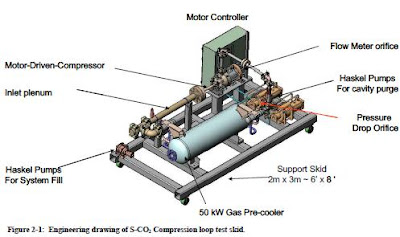Research focuses on supercritical carbon dioxide (S-CO2) Brayton-cycle turbines, which typically would be used for bulk thermal and nuclear generation of electricity, including next-generation power reactors. The goal is eventually to replace steam-driven Rankine cycle turbines, which have lower efficiency, are corrosive at high temperature and occupy 30 times as much space because of the need for very large turbines and condensers to dispose of excess steam. The Brayton cycle could yield 20 megawatts of electricity from a package with a volume as small as four cubic meters.
The Brayton cycle, named after George Brayton, originally functioned by heating air in a confined space and then releasing it in a particular direction. The same principle is used to power jet engines today. “This machine is basically a jet engine running on a hot liquid,” said principal investigator Steve Wright of Sandia’s Advanced Nuclear Concepts group.
A competing system, also at Sandia and using Brayton cycles with helium as the working fluid, is designed to operate at about 925 degrees C and is expected to produce electrical power at 43 percent to 46 percent efficiency. By contrast, the supercritical CO2 Brayton cycle provides the same efficiency as helium Brayton systems but at a considerably lower temperature (250-300 C). The S-CO2 equipment is also more compact than that of the helium cycle, which in turn is more compact than the conventional steam cycle.
Operation and Analysis of a Supercritical CO2 Brayton Cycle (101 pages)
Schematic of supercritical compression loop using a 50 kWe motor driving a radial compressor at 75,000 rpm with a flow rate of 3.51 kg/s
Schematic drawing of the motor-driven S- CO2 compressor. This configuration uses ball bearings and has no turbine.
Simple diagram of the heated un-recuperated supercritical CO2 Brayton loop.
Photo of the heated, but un-recuperated, Brayton Loop. The foreground shows the heaters, the back ground shows the modified S-CO2 test loop with the turbomachine configured as a turbo-alternator-compressor.
Expected operating conditions of the S-CO2 compression test loop at the design point and on the liquid and vapor sides of the dome.
Wikipedia on the Brayton cycle
FURTHER READING
Coverage from 2009 on supercritical CO2 recompression cycle
MIT CANES – Supercritical CO2 Brayton Cycle for Medium Power Applications (2007)
This final report summarizes the results of the study of a supercritical CO2 (SCO2) power cycle for medium power application. The objective of these investigations is to establish a 5 – 30MWe power conversion system for an indirect cycle that (1) achieves high net efficiency in conversion from thermal to electrical energy, (2) is compact with minimum volume and weight, (3) is robust, resilient to accidents and has high long term reliability and performance, and (4) exhibits good controllability and fast response to requested power changes.
Supercritical CO2 (S-CO2)operated in a closed-loop recompression Brayton cycle offers the potential of equivalent or higher cycle efficiency versus supercritical or superheated steam cycles at temperatures relevant for CSP applications. The S-CO2 pressure is higher than superheated steam but lower than supercritical steam at temperatures of interest. The high pressure required for S-CO2 make application to trough fields difficult and the fluid may be better suited for use in Power Towers. Even circulating high pressure S-CO2 through a large Power Tower would be challenge due to the volume and pressure of fluid being moved. However, a modular power tower design can take advantage of S-CO2’s potential without prohibitive piping costs. In the proposed design a single-phase process using S-CO2 as both heat transfer fluid (HTF) and thermal cycle fluid simplifies the power block machinery and is compatible with sensible-heat thermal energy storage, if desired. The simpler machinery and compact size of the S-CO2 process may also reduce the installation, maintenance and operation cost of the system. Brayton-cycle systems using S-CO2 have smaller weight and volume, lower thermal mass, and less complex power blocks versus Rankine cycles due to the higher density of the fluid and simpler cycle design.
Study of Supercritical Carbon Dioxide Power Cycle for Low Grade Heat Conversion
This paper conducts a comprehensive study on the feasibility of a CO2-based supercritical power cycle for low-grade heat conversion. Energy and exergy analysis of the cycle were conducted to discuss the obstacles as well as the potentials of using supercritical carbon dioxide as the working. As a working fluid for supercritical Rankine cycle, carbon dioxide has desirable qualities such as low critical temperature, stability, little environmental impact and low cost. However, the low critical temperature might be a disadvantage for the condensation process. Comparison between a carbon dioxide-based supercritical Rankine cycle and an organic fluid-based supercritical Rankine cycle showed that the former needs higher pressure to achieve the same efficiency and a heat recovery system is necessary to desuperheat the turbine exhaust and pre-heat the pressure charged liquid. Important thermophysical property of carbon dioxide, such as its critical point, thermal conductivity, and stability were also discussed. Regarding the thermal efficiency, some organic fluids can outperform carbon dioxide.
If you liked this article, please give it a quick review on ycombinator or StumbleUpon. Thanks

Brian Wang is a Futurist Thought Leader and a popular Science blogger with 1 million readers per month. His blog Nextbigfuture.com is ranked #1 Science News Blog. It covers many disruptive technology and trends including Space, Robotics, Artificial Intelligence, Medicine, Anti-aging Biotechnology, and Nanotechnology.
Known for identifying cutting edge technologies, he is currently a Co-Founder of a startup and fundraiser for high potential early-stage companies. He is the Head of Research for Allocations for deep technology investments and an Angel Investor at Space Angels.
A frequent speaker at corporations, he has been a TEDx speaker, a Singularity University speaker and guest at numerous interviews for radio and podcasts. He is open to public speaking and advising engagements.









